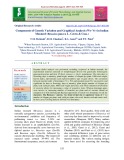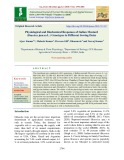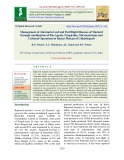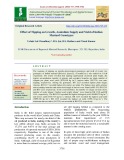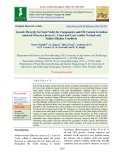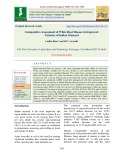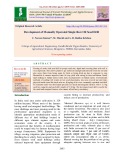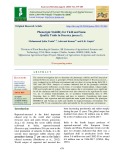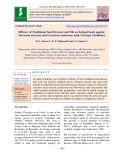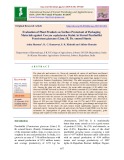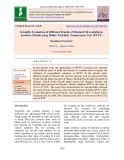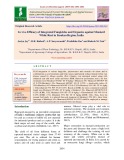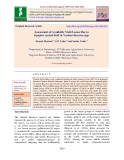
Mustard seed oil
-
In India, oilseed Brassica are grown over an area of about 6.3 million hectares with an annual production of 7.92 million tones with an average yield of 1304 kg/ha whereas in Rajasthan it was still 1422kg/ha. The severe attack of many diseases not only deteriorates the quality of the seed, but also reduces the oil content considerably. Among the diseases, white rust caused by Albugo candida (Pers. Ex Hook) O. Kuntze, is an important disease of a wide variety of Brassica crops. Its infection causes disfiguring white pustules on leaves, flowers stems and pod leading to yield losses.
 6p
6p  chauchaungayxua10
chauchaungayxua10
 19-03-2021
19-03-2021
 16
16
 1
1
 Download
Download
-
Mustard crop is mainly grown in the marginal/poor soils mainly under rainfed conditions with marginal inputs. A field investigation was carried out at Regional Agriculture Testing and Demonstration Station Bilwa, Bareilly district of Uttar Pradesh. The influence of fertilization on yield and quality on growth, yield and seed quality of mustard (Brassica juncea L.) cultivar Kranti was studied.
 8p
8p  chauchaungayxua10
chauchaungayxua10
 19-03-2021
19-03-2021
 17
17
 2
2
 Download
Download
-
Stem and Pod rot caused by Sclerotium rolfsii is one of the major constraint affecting the seed and oil production in groundnut growing areas of the world. An attempt was made to manage the disease by holistic approach. In vitro evaluation of different concentrations of mustard was conducted using two types of methods...
 6p
6p  gaocaolon9
gaocaolon9
 22-12-2020
22-12-2020
 15
15
 1
1
 Download
Download
-
Seventy five crosses of Indian mustard [Brassica juncea (L.) Czern & Coss] generated by crossing of fifty lines with five testers in a line x tester mating design, which were used to estimate the standard heterosis potentiality for seed yield, its component traits and oil content. These parents, crosses and checks were sown in randomized complete block design under four environments each replicated thrice at two different locations. Observations were recorded on thirteen different characters.
 9p
9p  trinhthamhodang1215
trinhthamhodang1215
 23-09-2020
23-09-2020
 10
10
 2
2
 Download
Download
-
Hayman diallel analysis was performed excluding reciprocal in Indian mustard, the experimental material consisted of morphological diverse but genetically homozygous genotypes/varieties and their 45 direct crosses i.e., the F1 populations. The traits days to flowering, days to maturity, plant height, number of siliquae per plant, 1000-seed weight, harvest index, and linolenic acid explored additive type of gene effects.
 11p
11p  nguaconbaynhay6
nguaconbaynhay6
 24-06-2020
24-06-2020
 11
11
 1
1
 Download
Download
-
The experiment was conducted with 6 genotypes of Indian mustard (Brassica juncea L.) viz RH-0116, RH-725, RH-923, RH-1019, RH-1077, RH-1301 for three dates of sowing i.
 8p
8p  nguaconbaynhay6
nguaconbaynhay6
 23-06-2020
23-06-2020
 14
14
 0
0
 Download
Download
-
Rapeseed-mustard accounts for 19.97 per cent of the total oilseeds production in India and it is one of the major contributors to Yellow Revolution. Their yield losses due to Alternaria blight was reported in the range of 10 to 70 per cent variable. The seed quality, seed size, colour and reduction of oil up to 10 per cent and seed germination ability is also adversely affected due to this disease in addition to quantities yield losses.
 5p
5p  gaocaolon5
gaocaolon5
 14-06-2020
14-06-2020
 14
14
 2
2
 Download
Download
-
The response of nipping on morpho-physiological parameters and yield of twenty two genotypes of Indian mustard [Brassica juncea(L.) Czern&Coss.] was studied in a field experiment. The results revealed that nipping significantly increased plant height, dry matters accumulation, number of primary and secondary branches per plant, number of sillquae per plant, seed yield (2678.146 kg ha-1 ), harvest index (30.57%) over nonnipping. respectively.
 7p
7p  trinhthamhodang5
trinhthamhodang5
 16-05-2020
16-05-2020
 11
11
 2
2
 Download
Download
-
The twenty genotypes along with four checks in Indian mustard (Brassica juncea L. Czern & Coss.) were studied for genetic diversity with respect to seed yield and thirteen related traits under normal condition (NS) and saline/alkaline condition (SS). D2 analysis classified the twenty genotypes of Indian mustard into five diverse clusters in both the conditions.
 7p
7p  chauchaungayxua5
chauchaungayxua5
 08-05-2020
08-05-2020
 31
31
 0
0
 Download
Download
-
Indian mustard (Brassica juncea) is the most important and major edible oil seed crop. White rust [Albugo candida (Pers. Ex.Lev.) Kuntze] is the important disease which can cause major yield losses in Indian Mustard. This study shows comparative assessment of white rust disease index (%), white rust disease severity and white rust disease incidence on leaves as well as on the inflorescence in the improved varieties of Indian Mustard.
 8p
8p  angicungduoc4
angicungduoc4
 26-04-2020
26-04-2020
 9
9
 1
1
 Download
Download
-
An experiment was conducted during 2014-2015 to study the oil and fatty acids content in 26 genotypes of Brassica species. Significant differences (p≤0.05) were observed among the genotypes for the oil quality, viz. oil content and fatty acids content. Oil content is in the range of 32.67–39.47%, 37.82–40.56% and 40.35–41.43% in Brassica juncea, Brassica napus and Brassica rapa seeds, respectively. The saturated fatty acid (Palmitic acid) content is in the range of 3.08–3.85, 3.70–5.15, 2.75–3.
 10p
10p  angicungduoc4
angicungduoc4
 26-04-2020
26-04-2020
 11
11
 0
0
 Download
Download
-
Sowing of seeds with seed drill at proper seed rate, depth and covering them with soil is very important. This allows plants to get sufficient sunlight and nutrients from the soil and also saves them from being eaten by birds or being dried up due to exposure to sun. Meanwhile it ensures improved ratio of crop yield with saving in time and labour. Small land holding in Indian farms limits farm mechanization on Indian farms. Conventional methods of seeding will results in low seed placements, less area covered per unit time, physical health issue like back ache etc.
 6p
6p  trinhthamhodang4
trinhthamhodang4
 22-03-2020
22-03-2020
 12
12
 2
2
 Download
Download
-
The current investigation aims to determine the phenotypic stability and GxE interaction among the Brassica juncea L. genotypes. Fifteen released genotypes of Brassica juncea L. were evaluated in two different environments and two dates of sowing during Rabi 2014- 2015 and 2015-2016. Analysis of variance indicated that all the genotypes exhibited significant genetic differences except forno. of secondary branches/plant, siliqua length, 1000 seed weight and oil content.
 7p
7p  cothumenhmong4
cothumenhmong4
 25-03-2020
25-03-2020
 9
9
 1
1
 Download
Download
-
In seeds of Isabgol, test of relative efficacy of four traditional seed dresser like tulsi leaf powder, mehandi leaves, turmeric powder and neem leaf powder revealed that neem leaf powder gave effective control of Alternaria alternate and Fusarium semitectum are followed by tulsi leaf powder and which resulted increased into germination even after 6 month storage as compared to control. Four oils like neem, mustard, castorl and palas oil were used for seed treatment and it was observed that the neem oil gave effective control even after six months of storage as compared to control.
 9p
9p  caygaocaolon2
caygaocaolon2
 14-03-2020
14-03-2020
 12
12
 2
2
 Download
Download
-
The plant oils and extracts viz., Neem oil, mustard oil, castor oil and Neem seed kernel extract each at three concentrations (5.0, 7.5 and 10%) and an insecticide check malathion 50 EC (0.05 and 0.1%) were evaluated by impregnating the gunny bags against Corcyra cephalonica Stainton (Lepidoptera: Galleriidae). The adult emergence, grain damage and weight loss were recorded after 270 days of storage pearlmillet, Pennisetum glaucum (Linn.). The adult emergence decrease with the increase in the concentration of test plant oils. Among the plant oils and extracts, the mean adult emergence (1.
 9p
9p  caygaocaolon2
caygaocaolon2
 11-03-2020
11-03-2020
 12
12
 2
2
 Download
Download
-
In this present work, the applicability of BTTT to mustard oils obtained from different parts of India and thereby to examine and investigate the influence of geographical variations on BTTT. In the present study, different brands of mustard oils used for analysis, such as mustard oil (Mu, Suraj), Kacchi ghani mustard oil (Kgmu, Mashal) Kacchi ghani mustard oil (Kgmu1, Nature fresh), Kacchi ghani mustard oil (Kgmu2, Engine) and Kacchi ghani mustard oil (Kgmu3, Saloni) exhibited BTT in the range of 26.8 to 27.5S0C. The result have demonstrated the reproducibility through the analyzed data.
 6p
6p  caygaocaolon3
caygaocaolon3
 09-03-2020
09-03-2020
 6
6
 0
0
 Download
Download
-
Field integration of various fungicides, phytoextracts and essential oils (alone and in combination) as seed treatments and foliar sprays significantly reduced mustard white rust disease caused by Albugo candida (Pers.) Kuntze, over untreated control, along with enhanced seed and straw yields and better ICBR. Based on performance merit, the best treatments were Metalaxyl 35%SD- ST @ 6g/kg + Metalaxyl 4%+ Mancozeb 68%WP- FS @ 0.25%>Metalaxyl 4%+ Mancozeb 68%WP -FS @ 0.25% + Azadirachta indica @ 20%>Metalaxyl 4%+ Mancozeb 68%WP- FS @ 0.
 11p
11p  cothumenhmong3
cothumenhmong3
 22-02-2020
22-02-2020
 15
15
 1
1
 Download
Download
-
A field experiment was conducted to study the effect of zinc and boron levels on yield, quality and nutrient uptake in mustard under Northern transition zone of Karnataka during rabi, 2017 at MARS, UAS, Dharwad with 10 treatments. The treatment comprised of two levels of zinc (10 kg ha-1 and 20 kg ha-1 ) and two levels of boron (1 kg ha-1 and 2 kg ha-1 ) and their combinations. These treatments were compared with RDF + FYM @ 5 t ha-1 and RDF (60:50:40 N: P2O5: K2O) alone. The treatments were replicated thrice in a randomized block design.
 6p
6p  chauchaungayxua3
chauchaungayxua3
 07-02-2020
07-02-2020
 14
14
 0
0
 Download
Download
-
Present field studies were conducted during the Rabi season of year 2015-16 at Regional Research Station, Rohtak (Haryana), India, to assess the yield losses due to mustard aphid in various Brassica spp. (B. juncea, B.napus and B. rapa) sown under early and late sown conditions. The avoidable losses in terms of seed yield varied from 9.26 to 17.48 per cent, found lowest (9.26%) in HNS 0901 whereas, highest (17.48%) in BSH 1 under timely sown conditions. These losses ranged from 20.11 to 32.62 per cent under late sown conditions, found lowest (20.11%) in HNS 0901 although highest (32.
 6p
6p  chauchaungayxua3
chauchaungayxua3
 07-02-2020
07-02-2020
 9
9
 1
1
 Download
Download
-
The investigation entitled “Effect of terminal heat stress on variability in physiological traits of Indian mustard (Brassica juncea L.) due to late sown situation” was conductedrabi season during 2017-18 and 2018-19 at Oil seed research Farm Kalyanpur of C. S. Azad University of Agriculture and Technology, Kanpur (U.P.) in randomized block design with three replications and twelve Indian mustard genotype. Physiological parameters i.e.
 9p
9p  nguaconbaynhay3
nguaconbaynhay3
 07-02-2020
07-02-2020
 18
18
 0
0
 Download
Download
CHỦ ĐỀ BẠN MUỐN TÌM









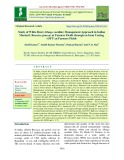
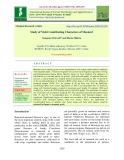
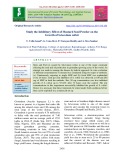
![Heterosis studies for seed yield and its component traits in Indian mustard [Brassica juncea (L.) Czern and Coss] over environments Heterosis studies for seed yield and its component traits in Indian mustard [Brassica juncea (L.) Czern and Coss] over environments](https://tailieu.vn/image/document/thumbnail/2020/20200923/trinhthamhodang1215/135x160/6361600825451.jpg)
